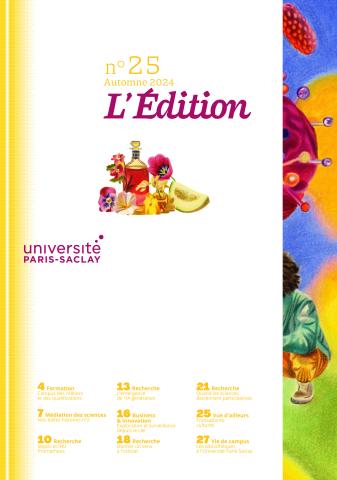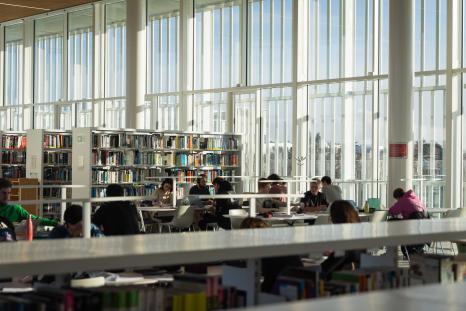
Libraries: at the intersection of research and student life
This article was originally published in L'Édition n°25.
The network of libraries at Université Paris-Saclay sets itself apart through its diversity and its constant ability to evolve to meet the needs of the university community. Continuously developing, this network is built around both university and research libraries, maintaining a strong connection between these structures.
Libraries are far more dynamic than their neatly arranged shelves suggest. Their staff closely observe and regularly adjust the operation and organisation of spaces to cater to the changing demands and varied profiles of their users. In 2023, over a million students, academics, researchers and entrepreneurs visited Université Paris-Saclay's network of libraries.
"All the libraries are designed to accommodate the variety of uses observed and the diverse audiences they welcome," explains Émilie Barthet, director of the Departmentof Libraries, Information and Open Science (DiBISO) at Université Paris-Saclay. This department oversees the definition and implementation of the university's documentary and open science policies, coordinating between the documentary and cultural facilities of Université Paris-Saclay, CentraleSupélec and ENS Paris-Saclay.
University libraries, the most important service for student life
"The 2023 national survey by the Observatory of Student Life showed that 85%of students consider university libraries to be the most important service for student life," says Émilie Barthet. Université Paris-Saclay has four university libraries (UL): the Orsay library on the Vallée campus, the Sceaux library on the campus of the Jean Monnet Faculty, the Kremlin-Bicêtre library and the Lumen on the Moulon plateau.
For several years, DiBISO has been conducting user experience surveys and observations, leading to the regular introduction of new services to facilitate the multiple uses of the libraries. At the Sceaux library, this has resulted in the addition of five rooms for group work and play. At the Kremlin-Bicêtre library, renovations are underway to increase seating capacity. The Orsay library has redesigned its foyer to include leisure collections, relaxation areas and a welcome desk for international students.
Another symbol of the revival of libraries and a true hub of campus life at Gif-sur-Yvette campus, Lumen was designed to host not only the activities and services of a university library, but also, more broadly, activities and services for teaching and research, culture, scientific outreach and innovation. It also houses the first publicly accessible materials library.
Libraries supporting research
Alongside the university libraries and Lumen, the research libraries within the Université Paris-Saclay network are also undergoing constant change, offering new services to meet the needs of their users. Some research libraries at Université Paris-Saclay have gained a reputation for excellence across the entire scientific community by offering high quality collections in certain disciplines, such as mathematics and law. These libraries provide documentary services and methodological support, primarily aimed at researchers, but from which master's and PhD students can also benefit.
"The goal is to offer services that are timely and relevant, by anticipating the needs of researchers and advanced students, always with a view to being useful to them and facilitating their research activities," explains Angélique Malec, coordinator of Université Paris-Saclay's associated libraries and manager of the research library at Jean Monnet Faculty in Sceaux. "In particular, we offer services tailored to their disciplines," such as digitisation and online access to heritage collections and scientific archives.
"Research advisors" to support researchers
The challenge for these libraries, which are often affiliated with one or more research laboratories, is to maintain lasting relationships with research staff, acting as a direct link to DiBISO. "I like to say that weare ‘permanently based in the laboratories’, as our close proximity to researchers helps us to stay connected with the reality on the ground. This intermediary role enables us to act as a gateway, conveying their needs to DiBISO," adds Angélique Malec.
The network of university and research libraries has developed the role of "research advisors", who are responsible for assisting researchers in submitting their publications to the HAL platform and managing their data in line with the university's open science policy. University and research libraries also provide students with the opportunity to train in documentary research and electronic resources and receive methodological assistance for writing their dissertations.
Numaclay, a digital library of exceptional works
The research libraries sometimes house exceptional works, such as the library of the Law and Religious Societies (DSR) research centre in Sceaux. In 2009, this centre acquired a legal history collection from the library of legal scholar Gabriel Le Bras, containing a treasure trove of around one hundred 16th-century works, including some very rare volumes.
The work carried out on this heritage collection led to the creation of an iconic project in 2016: the "Yvette" digital library, a collaboration between DSR centre researchers, research library staff and Sceaux UL staff. During the project's firstphase, no fewer than 30,000 pages ofbooks, including those acquired by the DSR centre, were digitised. Yvette has since been integrated into the Numaclay digital library, along with several other collections. "This is a great example of what can beachieved through a partnership between a research library, researchers and a university library," says Angélique Malec, who was involved in the project. Such initiatives "also help research centres to raise their profile through documentary collections beyond their usual scientific circles."
While libraries remain places of "resources", they are no longer limited to documentary services, conservation and the lending of physical books. They are evolving to meet the new needs of their users, remaining spaces for both work and research, but also for relaxation and student life.
Learn more:
- https://www.universite-paris-saclay.fr/en/bibliothequesuniversitaires-bu/
- About the digital librairy Numaclay: https://numaclay.universite-paris-saclay.fr
The Orsay University Library
Founded in 1962, the Orsay University Library (UL) is located at the heart of Université Paris-Saclay's Vallée campus. This library initially focused on life sciences due to its proximity to the Orsay Faculty of Sciences. This led the Maison de la Chimie (Chemistry House) to gift some of its collections to enhance the collections of this fledgling library.
Like the rest of the university campus, therole of the Orsay UL has evolved significantly and it now welcomes 300,000 visitors annually. At a time when digital resources are consulted fifty times more often than printed documents, the Orsay UL has expanded its scientific information and mediation mission. Claire Lemauff, library manager, explains: "We play a keyrole, particularly for undergraduate students,who often have their first experience with documentary research here. We help them learn how to make the most of the library's resources, spaces and working methods."
Exhibitions and equipment loans to diversify services
Along with the entire library network, the Orsay UL continues to diversify. While it still offers print anddigital resources, its spaces are increasingly used by students to work or relax, alone or in groups, without necessarily consulting or borrowing materials. "We are fully aware of the changing needs and uses of the libraries by students," says Claire Lemauff. "For instance, we host exhibitions, often themed, organised by student associations and provide services regularly requested by the community, such as the loan of headphones, atomic or anatomical models. Last year, we recorded over 3,500 computer loans."
In addition to facilitating access to specialised tools, the university library has created a relaxation area where students can read mangas and comic books, further enhancing the library's appeal and the range of facilities on offer.

This article was originally published in L'Édition n°25.
Find out more about the journal in digital version here.
For more articles and topics, subscribe to L'Édition and receive future issues:



